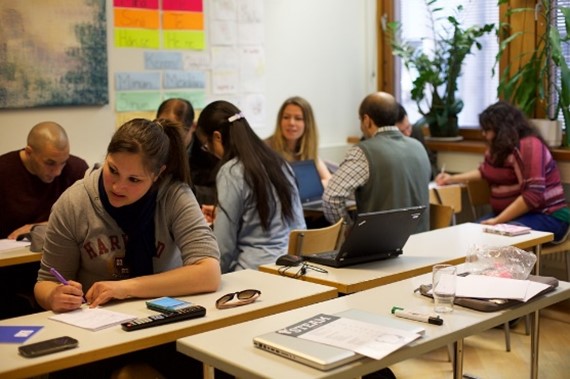Case Studies
The report on Case Studies can be downloaded via: Deliverables_5.3
The case study presents an example of research challenging common assumptions that self-confidence differs between men and women. It asks whether gaining influence varies per gender and examines the role of self-confidence appearance in influencing an organisation. Essential practices of gender integration include:
- Integrating the gender dimension throughout the research project, from the conceptualisation of the problem to the discussion of results.
- Specifying how the research findings have different practical implications for female and male employees, both at the individual and organisational levels.
Source: ESMT Berlin – European School of Management and Technology
The case study presents an example of research examining the impact of perceptions of the workplace on men’s and women’s turnover intentions and wellbeing. The context is that of Equal4Europe, a European-funded project which interrogates gender dynamics in research performing business development institutions. Women are persistently less represented in these fields, in higher ranks of the career pipeline. Whilst this is true across faculty groups, administrative and supportive roles are in majority held by women. Previous research in this context suggests that women feel less included and less supported in their workplaces. These different, gendered experiences may cause women to leave careers in research faculty to a greater extent than their male counterparts.
Source: INSEAD – European Institute of Business Administration
This case study presents an example of research studying gender differences in willingness to guess using approximately 10,000 multiple-choice math tests, where, for all participants, in half of the questions, omitted answers were rewarded, while for the other half, they scored the same as wrong answers. The analysis shows that female participants leave significantly more omitted questions than males when there is a reward for omitted questions. This gender difference, which is stronger among high ability and older participants, hurts female performance as measured by the final score and position in the ranking. Scoring rules that do not differentiate between wrong answers and omitted questions help avoid this negative effect.
Source: ESADE Business School
This case study describes the role of gender in an elective course on Managing Diversity and Inclusion for BBA students. Over the course, Students are required to analyse data on different dimensions or categories of diversity in contemporary societies and organisations and their organisational policies and proposed practices. Using critical analysis, we will identify the gap between existing policies and those required to achieve equality and full participation of employees in organisational life. Students, working in teams, will propose policies and specific actions to address this gap between rhetoric and reality effectively. Gender is one of the categories analysed, and most teams choose gender as one of the two dimensions of their project.
Source: ESADE Business School
The case study provides an example of how gender is addressed in teaching different SSH disciplines at Comenius University in Bratislava through presenting the gender-oriented courses across several study programmes (sociology, psychology, ethnology, political science, and elementary education) taught at the three SSH faculties. The case study builds on the analysis of the syllabus of the courses and focuses on the content of the course but does not address the pedagogical approaches and methods used in their delivery. It aims to demonstrate how integrating gender-oriented courses can not only contribute to a better understanding of the concept of gender, but also provides the students with tools for doing better and more relevant research and helps them develop practical skills for their professional practice.
Source: Comenius University in Bratislava
The case study builds on research into the history of philosophy which is commonly viewed and presented as a collection of ideas of as the history of the ideas of renowned men, where women are almost absent. It provides an example of how integrating gender perspective helps to enrich and correct the traditional picture about philosophy as male dominated enterprise, to reveal women philosophers and their ideas which are not included in the “philosophical canon”, but also hidden, or in some cases explicit androcentrism and sexism in philosophical theories. It also demonstrates how using gender perspective can improve our understanding of philosophy and its history.
Source: Comenius University in Bratislava
In order to enhance the gender ratio in the medium to long term, the mentoring programme at IEDC seeks to accelerate the academic careers of four women between the ages of 28 and 35. Gender balance among the faculty members would have a beneficial impact on the diversity of views and as such improved quality of research output. Mentees, each supported by their mentor who will compose a development plan with them, will have the opportunity to build on their research and teaching skills, benefit from training sessions and leadership development programs, and have opportunities for networking and participation in high-level research conferences.
Source: IEDC-Bled School of Management
In the spring of 2022, the Erasmus Centre for Women and Organisations organised, together with the Equal4Europe research team, the first Gender D&I lunch at Rotterdam School of Management.
The lunches are held once every quarter at a location on campus, and lunch is provided for all participants. Participants are invited to present their gender research, add items to the agenda and forward this initiative to other researchers at Erasmus University Rotterdam to widen the scope of this gathering.
Source: RSM – Rotterdam School of Management
The case study offers a personal insight of a researcher integrating gender in her ethnographic research project on the situation of Roma workers in the Czech Republic. The research itself aimed to bring a deeper understanding of racialized class formations in the post-socialist context. Barbora Černušáková explains how is gender related to the broader research question and what are the mechanisms through which it operates in her field of study. She provides examples illustrating that despite one’s commitment and sensitivity to gender equality, meaningful integration of gender into research requires constant dialogue between methods, data, and the structural context within which they are produced.
Source: Barbora Černušáková, PhD








